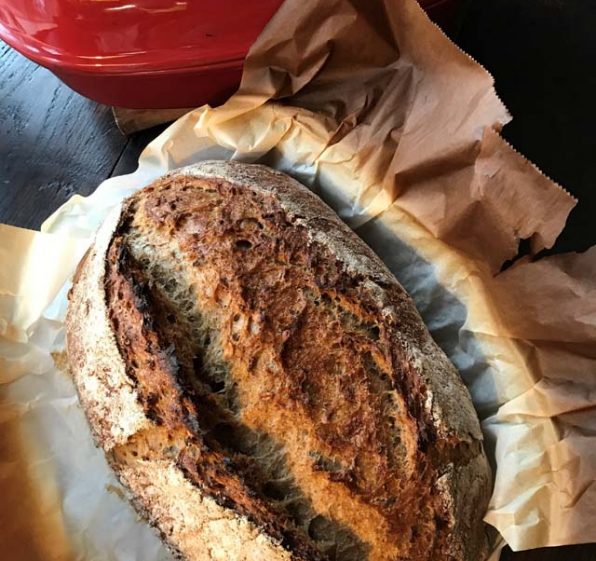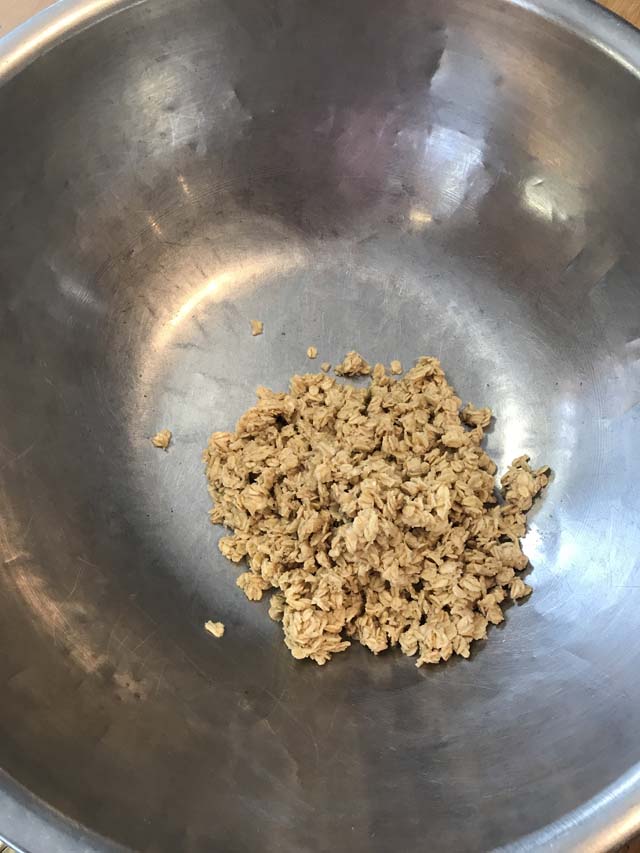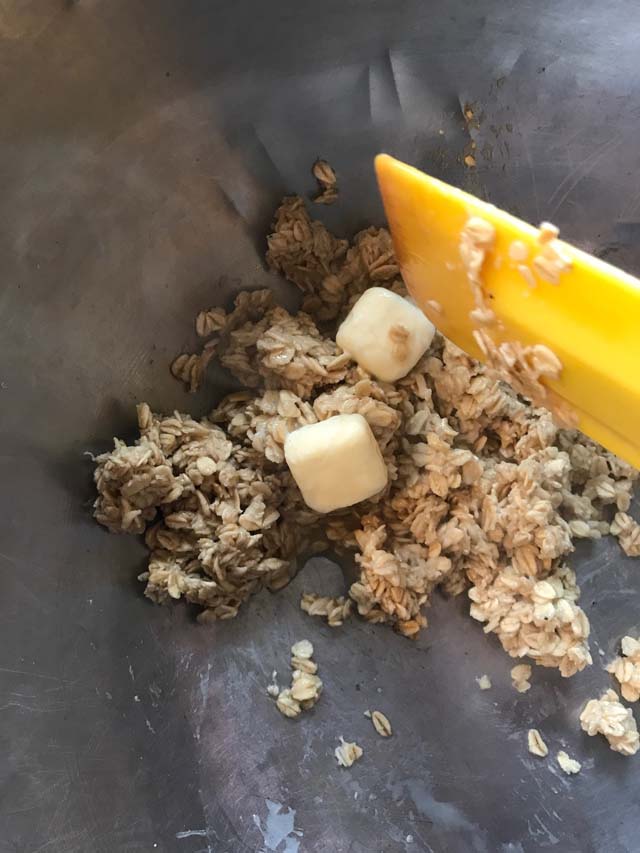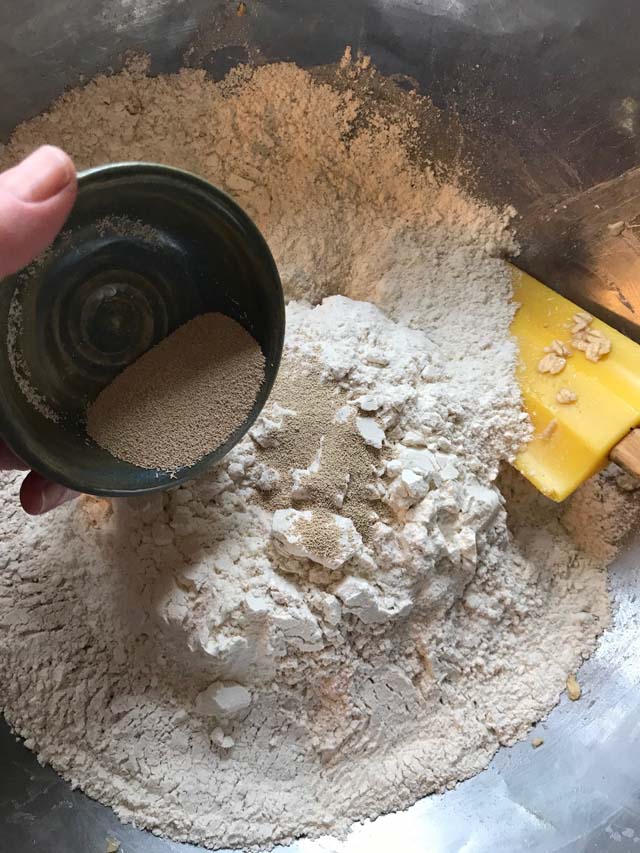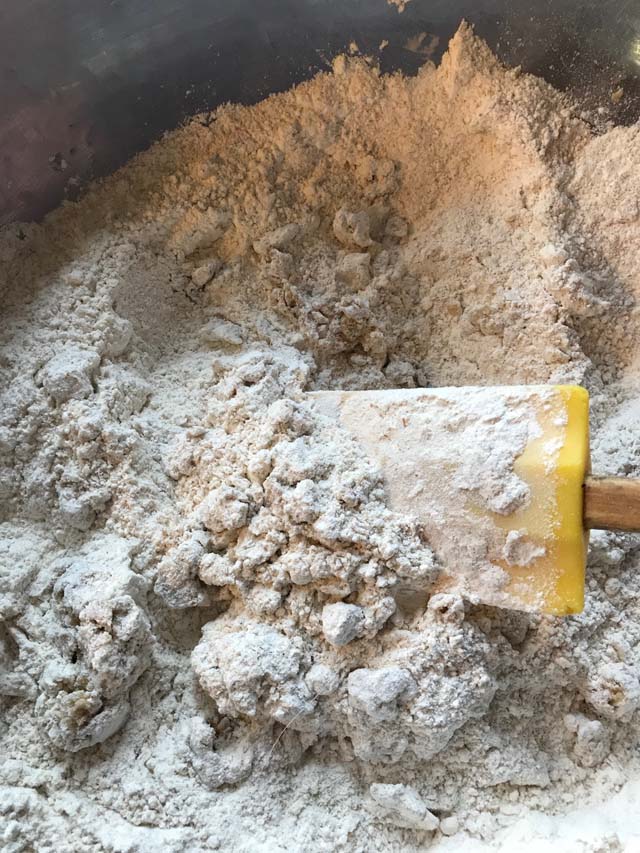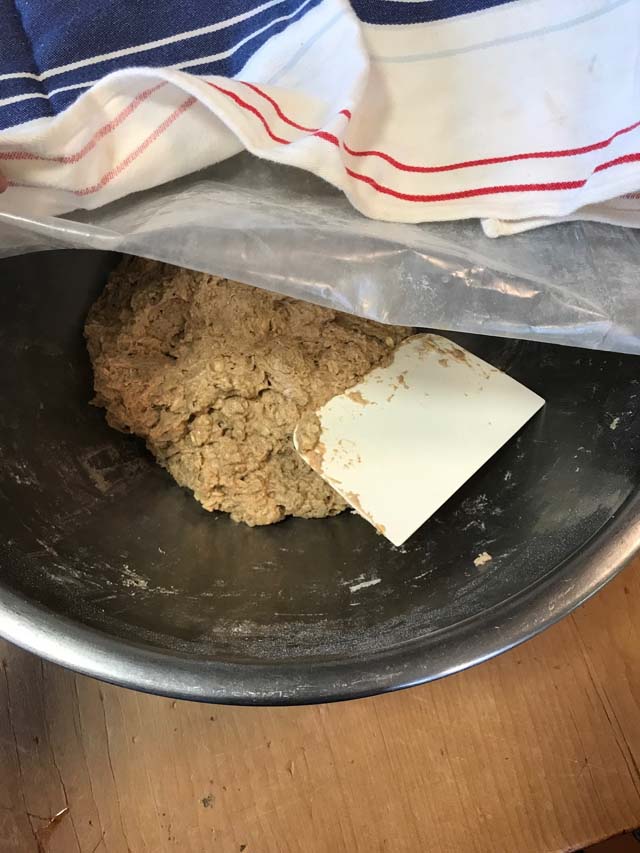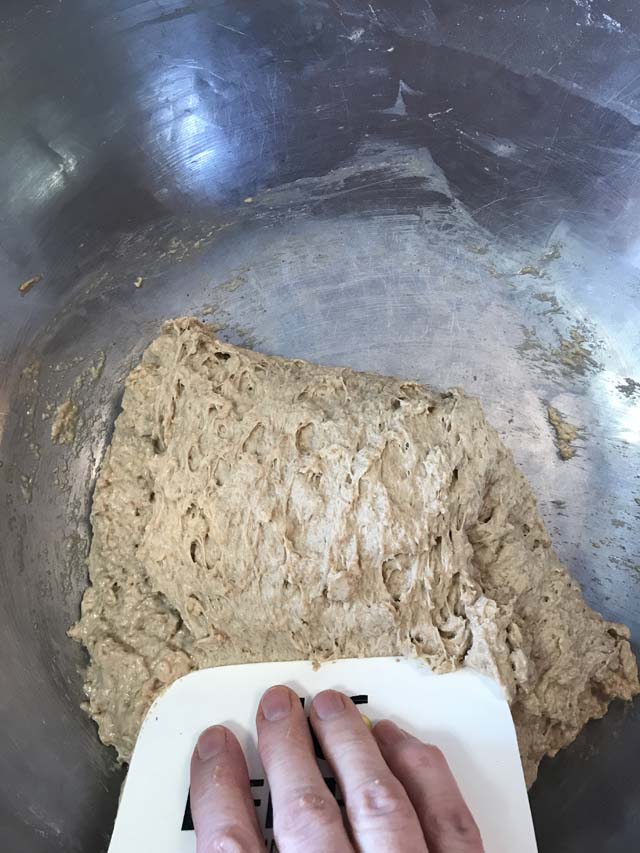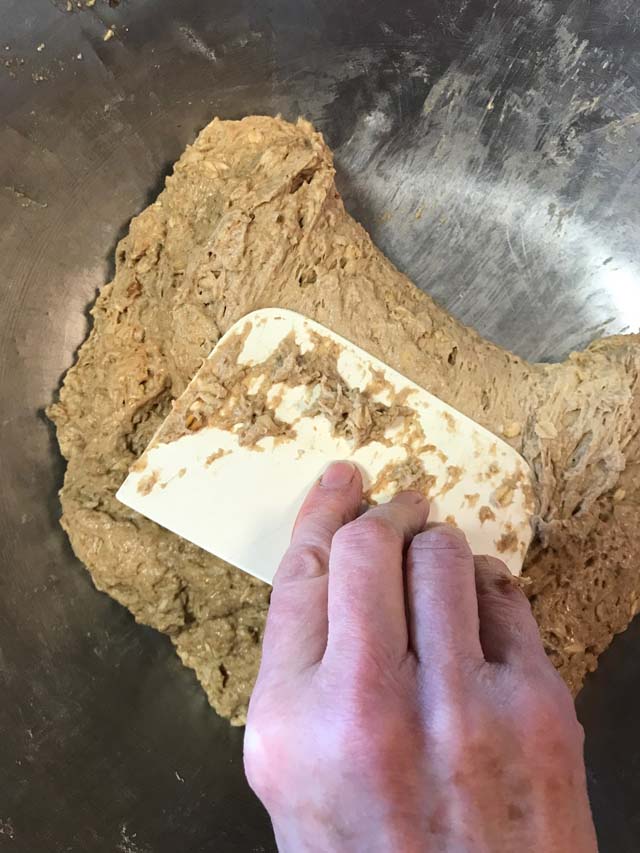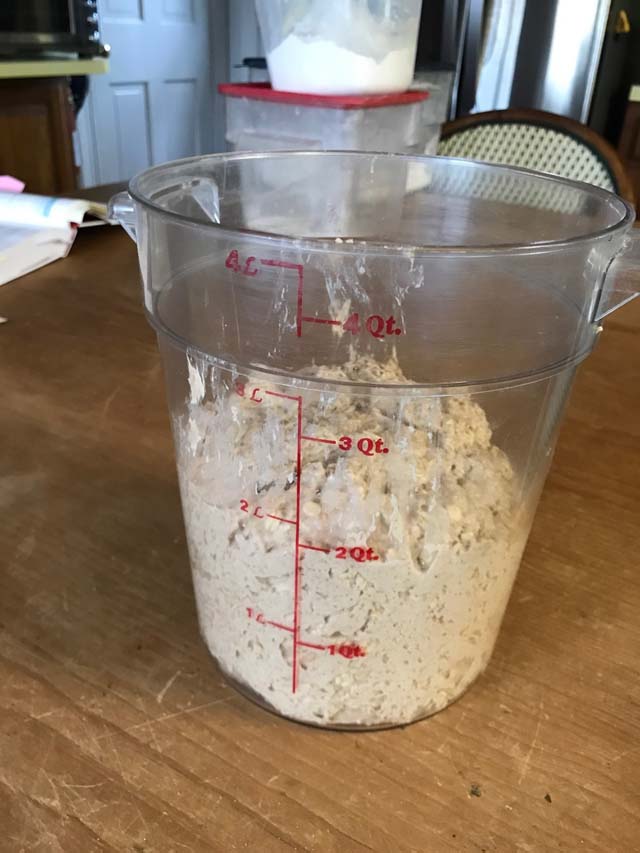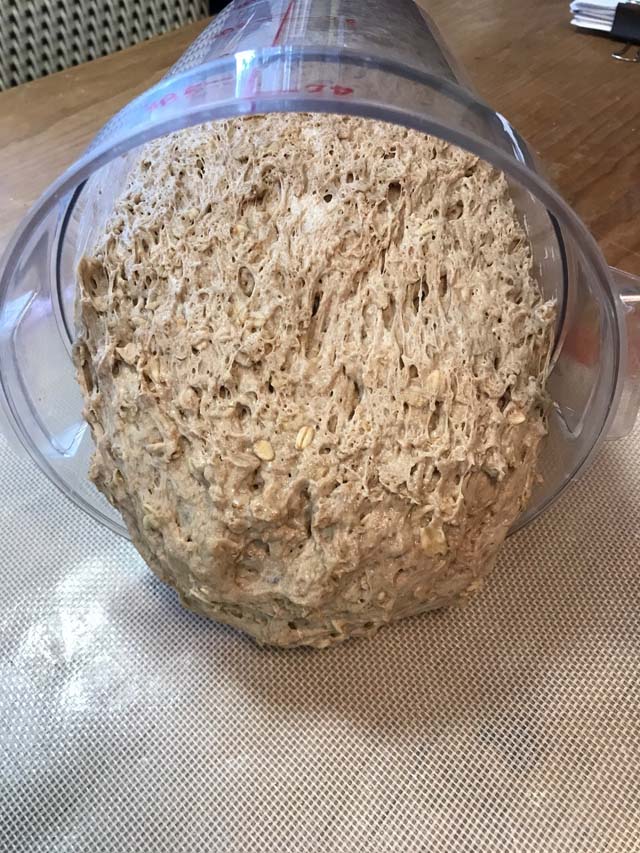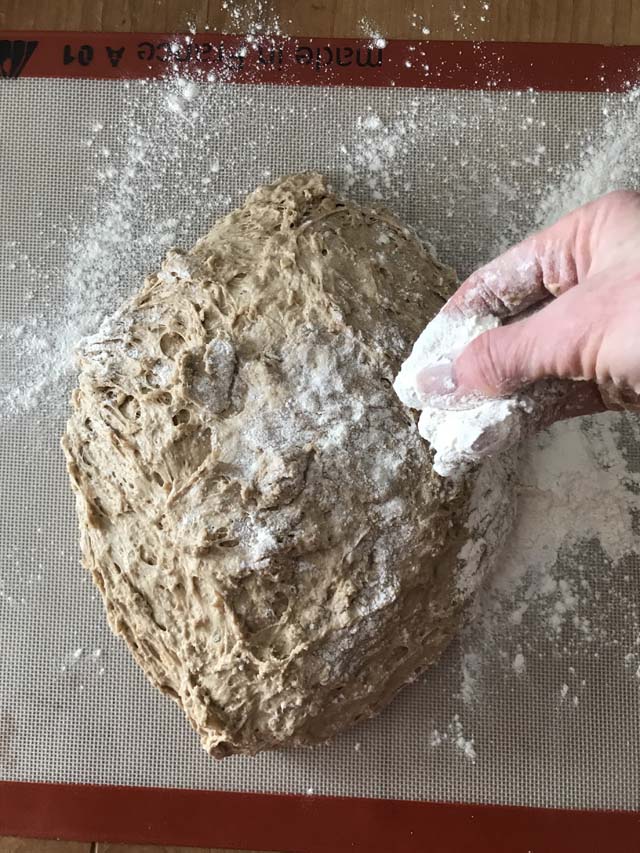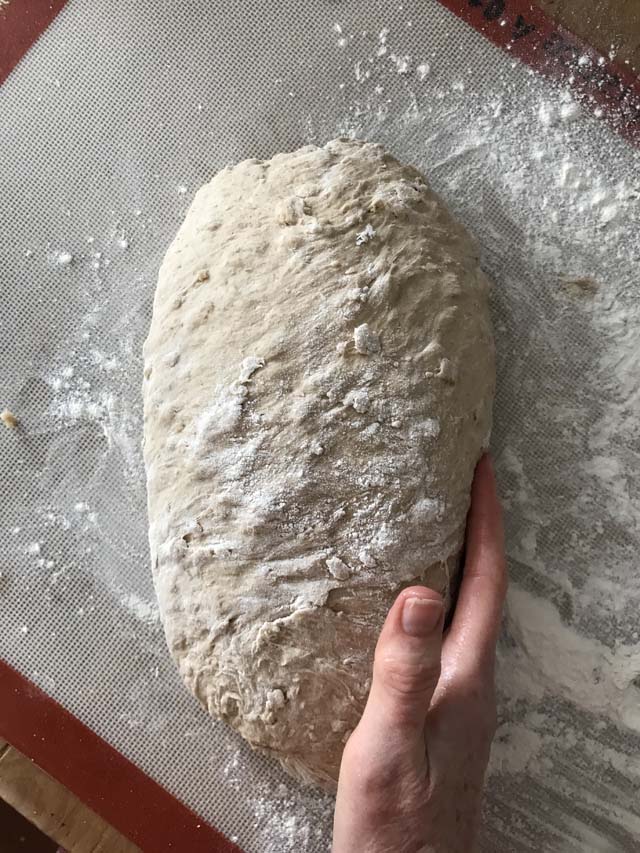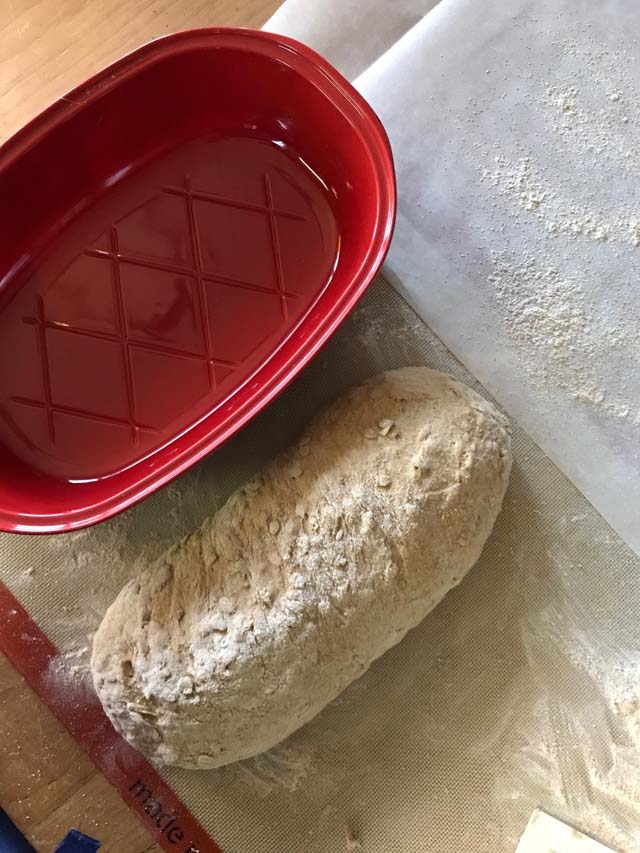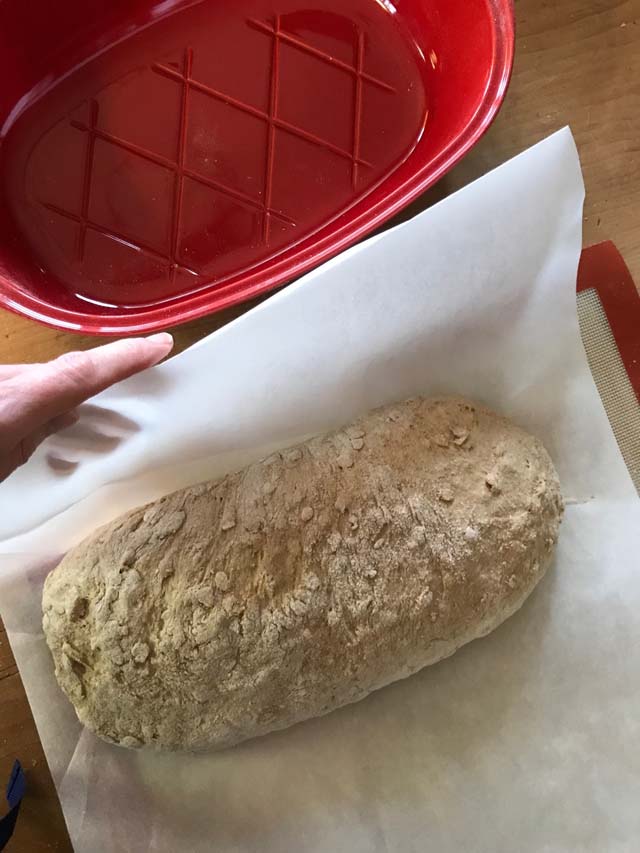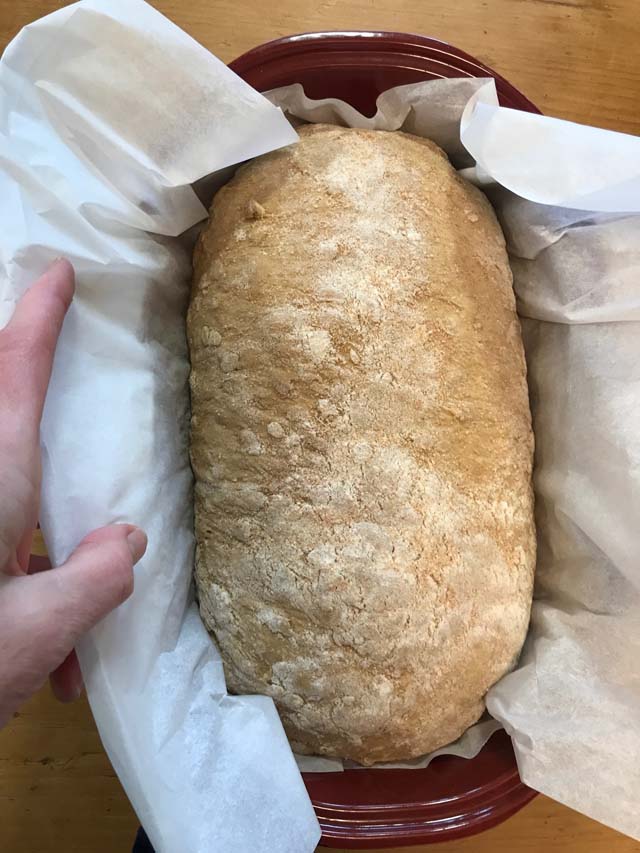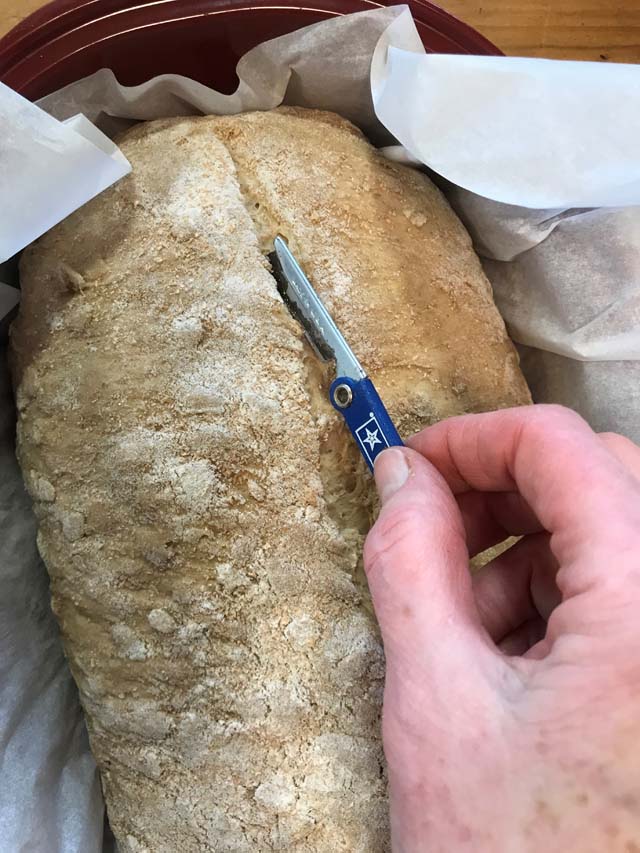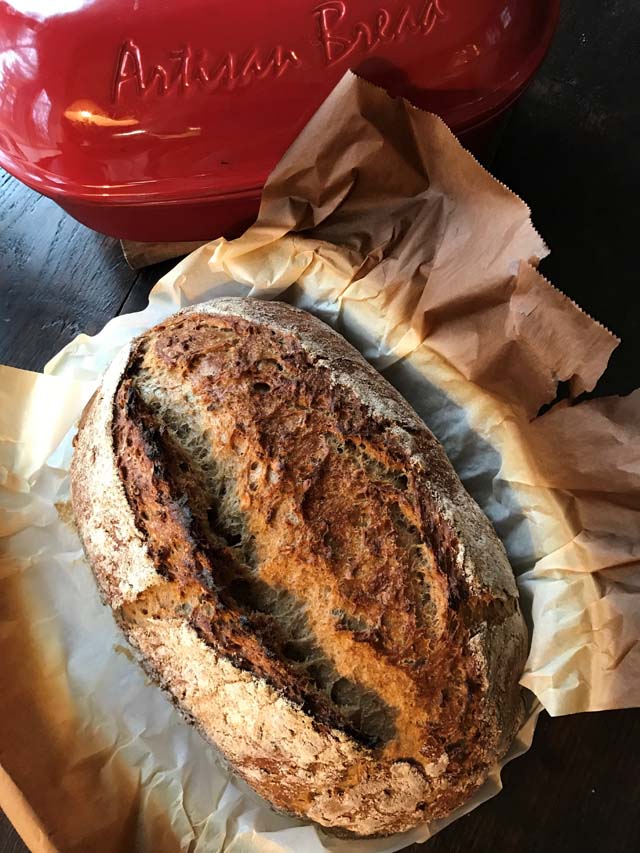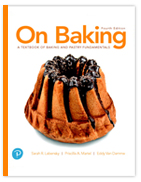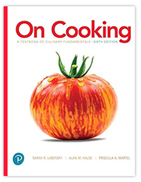All the flavors of whole wheat and oatmeal come together in this moist Oatmeal Stout Bread liberally flavored with intense dark beer. Make this bread for sandwiches, to serve with cheese or hearty Irish stew. Whichever you choose, know that this dough is a joy to mix by hand and delivers great flavor with the minimum of fuss.
Welcome to my celebration of National Flour Month and of making quality bread at home. My friends at Emile Henry are helping me spread the word with a month of product giveaways on Instagram. (Learn more at the link.)
For the first week, I’ve chosen a large loaf for a big family or for freezing. Oatmeal bread is one of the first I taught myself to make way back when I started baking. It’s moist, flavorful and forgiving. You make the sticky oatmeal dough by hand with inherently flavorful ingredients. If you chose to make this bread, you will gain experience handling wet dough, what bakers call a dough with high hydration. When there is lots of water or liquid in bread dough, it practically mixes itself. In fact, no knead bread dough recipes always contain a high percentage of liquid in relation to flour. This dough is based on cooked oatmeal, which also contributes moisture. It belongs to a style called “porridge bread.” The cooked old-fashioned oats give the bread a moist crumb and lingering texture.
There is not much to the mixing. You add the dry ingredients to the oatmeal then stir a little. Then you add the dark beer.
Here’s what you need to know. When preparing the oats, choose a small saucepan about 6 to 7 inches in diameter because you don’t want the water to evaporate too quickly before the oats soften. You cook the oats for about a minute then add some butter before you let the mixture cool to 100 to 110F. If it’s too hot, you’ll kill the yeast.
Here are the oats after cooking. I use a huge bowl to mix the dough for this recipe and anytime I mix by hand.
You add the butter and stir until it melts. Because the moist dough is soft, it is easy to mix with a large, flexible spatula.
Once the oatmeal mixture has cooled to the right temperature, add the dry ingredients and instant yeast.
Then stir to combine the dry ingredients and oatmeal.
Next comes our flavor enhancer, strong, dark stout beer. Here I am using Guinness Stout but there are dozens of local brews that would work well in this recipe. And do make sure that the beer is at room temperature. If it’s been in a refrigerator, place the unopened bottles in a bowl of warm water to remove the chill.
You need to stir the mixture until all of the flour is thoroughly moistened.
In about 3 to 5 minutes, you’ll have a nice soft dough. Stir for longer if you like. It’s a good opportunity to experience protein bonds forming in a wet dough.
At this point I switch to a firm dough scraper that I use to shape the dough into an even mound.
In yeast bread making, time does some of the work to knead dough. Resting the dough allows moisture to migrate into the flour, softening it and helping create the protein bonds that become stretchy gluten. I cover the dough with a clean sheet of heavy plastic and a bowl. (We buy the reusable plastic at a hardware or home improvement store.) In 30 minutes, the dough will be noticeably softer and more elastic.
Kneading helps combine and moisten ingredients. Kneading also activates protein in the flour so that they bind to form gluten, the elastic strings that give bread its heft and chew. In this recipe, you use a simple four-fold method to knead the dough. After it rests, you lift the dough up and fold it over onto itself four times.
Next the dough rises in a covered container as you can see here. If it is cool, I will fill the bucket with hot water to warm it. Then I’ll dry out the container before transferring the dough into it.
In 2 to 3 hours depending on the weather and temperature in your kitchen, the dough will double in volume as shown here. In winter when it is especially cold in my kitchen, I fill the sink or a large bowl with very warm water. Then I place the covered dough bucket into the water. This provides a uniform warm environment for the yeast to thrive causing the dough to rise.
I work on an unfinished wooden table in our kitchen. It’s like the wooden workbenches used in commercial bakeries. Because this dough is quite moist and sticky, I place a silicone baking mat on the table and flour it lightly. Here is the active dough flowing out of the bucket onto the prepared worktable. Imagine the rich smell of fermentation that comes from the dough.
To form this dough into a loaf shape, sprinkle it with some flour. Working gently, flatten the dough slightly with floured hands. Then gently pat it into an oblong shape.
Here my hand cups the dough, pushing it into a plump oblong the same length as the Emile Henry bread mold I am using. (See notes at the end for baking this dough without a mold.)
Proofing and Baking the Dough
There are two ways to proof and bake this dough. You can proof it in the Emile Henry bread loaf mold or in a very large, greased loaf pan. Or you can proof it on a sheet of parchment paper before. Regardless, because the dough is soft and moist, it must be proofed in a way that holds its shape.
There are several ways to do this. You could place the dough in a large and heavily floured banneton proofing basket. Or you can create your own set up as I have done here. I placed the formed loaf on a large sheet of parchment paper that I position between two large flour buckets. You can see how the buckets hold up the sides of the dough during proofing.
People who use Emile Henry covered bakeware often ask about whether the mold needs to be preheated before using. The answer is no, a sigh of relief for anyone who is concerned about handling a hot piece of ceramic bakeware. You just place the formed dough into the mold, using a sheet of parchment paper as a sling to help make transfer easy. Then cover and wait 30 minutes to an hour for the dough to rise the second time or proof before baking.
But you might like to preheat the mold in the oven. A preheated mold will encourage your dough to rise quickly and burst open on top achieving the grigne or crested score typical of well-crafted artisan bread. To see the difference, compare the top of the loaf pictured with ham and cheese and the featured image with this post, which was baked in a preheated mold.
When you transfer the dough into the mold, fold back the excess parchment paper. You don’t want it to end up inside the mold where it will mar the surface of the loaf as it bakes.
Whichever method you use, you must score the dough or cut a seam into its surface. This lets the dough expand during baking into a beautiful uniform shape. Here I use a razorblade mounted in a handle, something we were given by the Red Star Yeast Company. A special lame for this purpose of a serrated knife work well. I usually dust the top of my loaves with flour or some oatmeal to give them an attractive finish after baking. The lid goes on and the mold goes into the hot, preheated oven.
Here is the finished loaf, a gorgeous, burnished crust with an attractive sore that opened during baking.
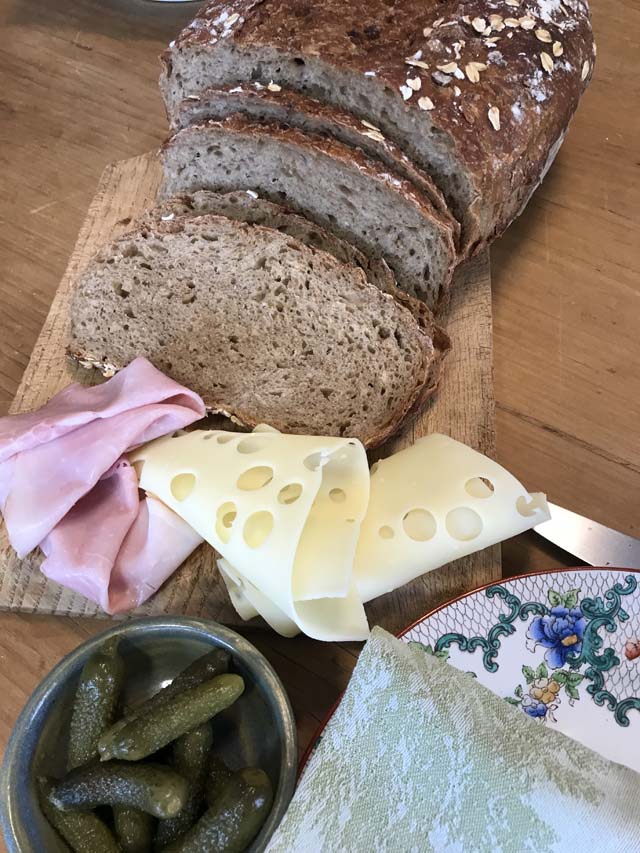
This recipe makes a superb moist dough and flavorful loaf. The dough is easy to handle as long as you remind yourself not to pummel the dough, making it so sticky you'll want to add more flour.
I used TWO bottles of Guinness Stout but you can use any brand you like, the darker and richer the better. I prefer to make large loaves of bread. Yeast activity is stronger in larger masses of dough. If you don't have the Emile Henry mold pictured here, use a large Dutch Oven.
Ingredients
For the Oatmeal
1 cup (225 grams) water
1 1/2 cups (150 grams) rolled oats, not quick cooking
2 Tablespoons (30 grams) butter
For the Dough
4 2/3-5 cups (600 grams) all-purpose flour
1 ¼ cups (160 grams) whole wheat flour
4 teaspoons (20 grams) fine salt
3 teaspoons (9 grams) instant yeast
22.4 fluid ounces (660 milliliters) Guinness Stout or other dark beer
Rolled oats, as needed for the mold, if desired
Directions
- Bring the water to a boil in a small saucepan. Add the rolled oats. Stir and cook for one minute until the oats begin to soften and the water has been absorbed and evaporated.
- Remove from heat. Scrape the oatmeal into a large mixing bowl. Add the butter and stir until it melts. Let the oatmeal cool to 100 to 110°F.
- To make the dough, add the flours, salt and yeast to the oatmeal mixture. Stir with a large rubber spatula. Then add the beer. Mix by hand, scraping the edges of the bowl until you have a sticky mound of dough with no specks of dry ingredients visible. Cover with a sheet of plastic or a damp towel and let sit for 30 minutes.
- Uncover the bowl. Using a flat dough scraper or moistened hands, fold the dough over onto itself along one side. Turn the bowl 180 degrees and repeat. Cover and let sit 30 minutes.
- Scrape the dough into a deep container large enough for the dough to expand to double its volume. Cover and let it rise until doubled, for about 2 to 3 hours.
- Scrape the dough out onto a floured work surface, preferable a silicone baking mat. Gather the dough, using a scraper, if necessary, into a uniform oblong shape a little shorter than the Emile Henry Artisan bread mold. Transfer the shaped dough onto a large sheet of baking parchment. Using the paper as a sling, lift the dough and place it into the Emile Henry Bread Mold. Sprinkle with some flour and uncooked oatmeal. Cover. Proof 45 minutes to an hour, longer if very cold.
- While dough proofs, preheat the oven to 500°F.
- Remove lid. Slash bread down the center using a serrated knife of bread lame. Spray with a little water. Cover. Place in the oven. Reduce the heat to 475°F. Bake for 45 minutes.
- Variation:
- To bake on a baking stone in Step 6, transfer the shaped dough onto a large sheet of parchment paper. Preserve the loaf’s shape by propping up each side between two tall objects such as square flour buckets. Place a baking stone on the center rack of the oven and preheat it for 30 minutes. Place a small cast iron skillet on the floor of the oven to preheat with the baking stone. Score the dough and then slide it onto the baking stone in the oven. Carefully pour 1 cup boiling water into the pan on the floor of the oven. Reduce the oven temperature to 475°F and bake for until the crust browns and the interior of the bread reaches 190 to 200°F, for 40 to 50 minutes.

